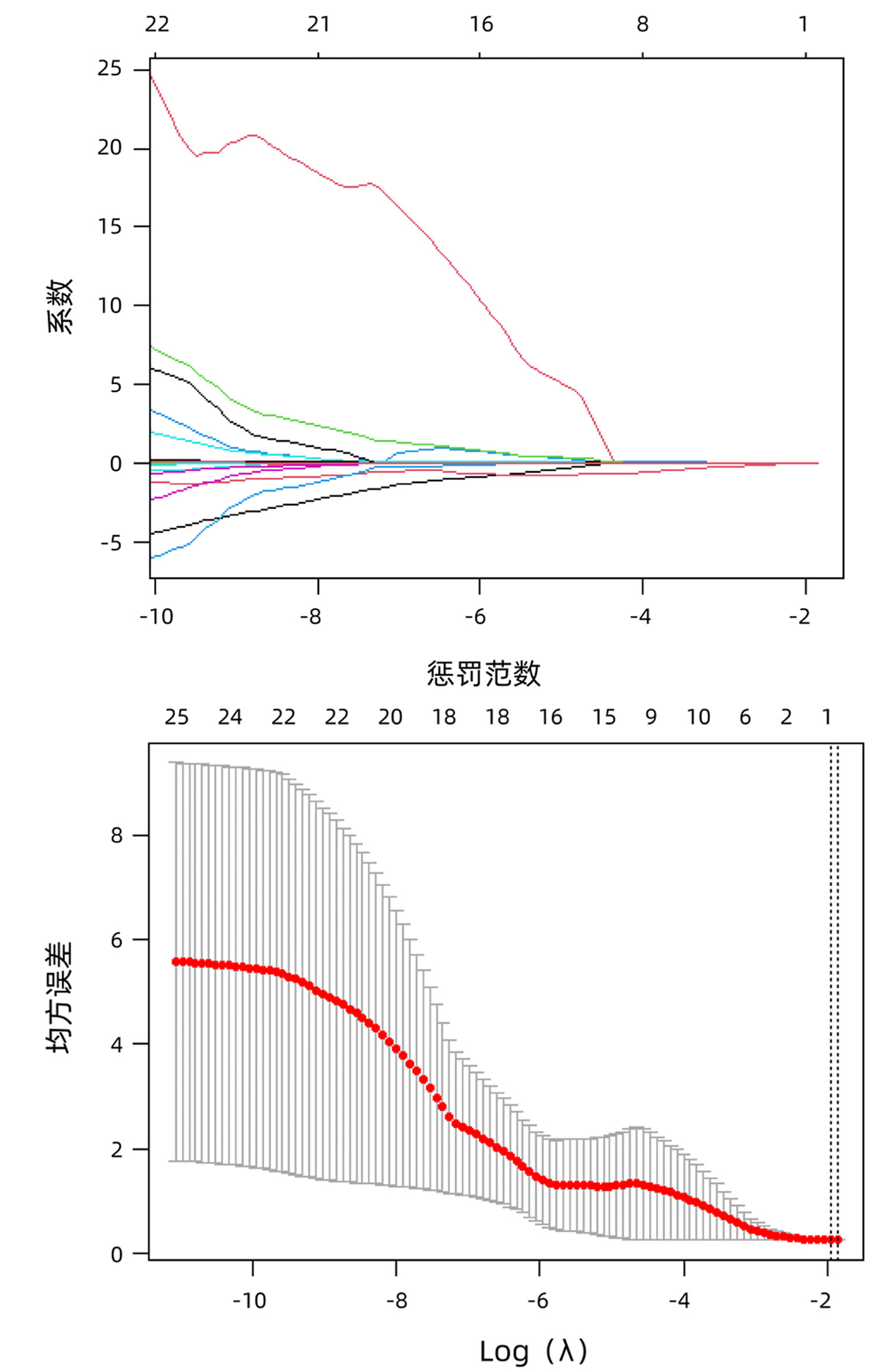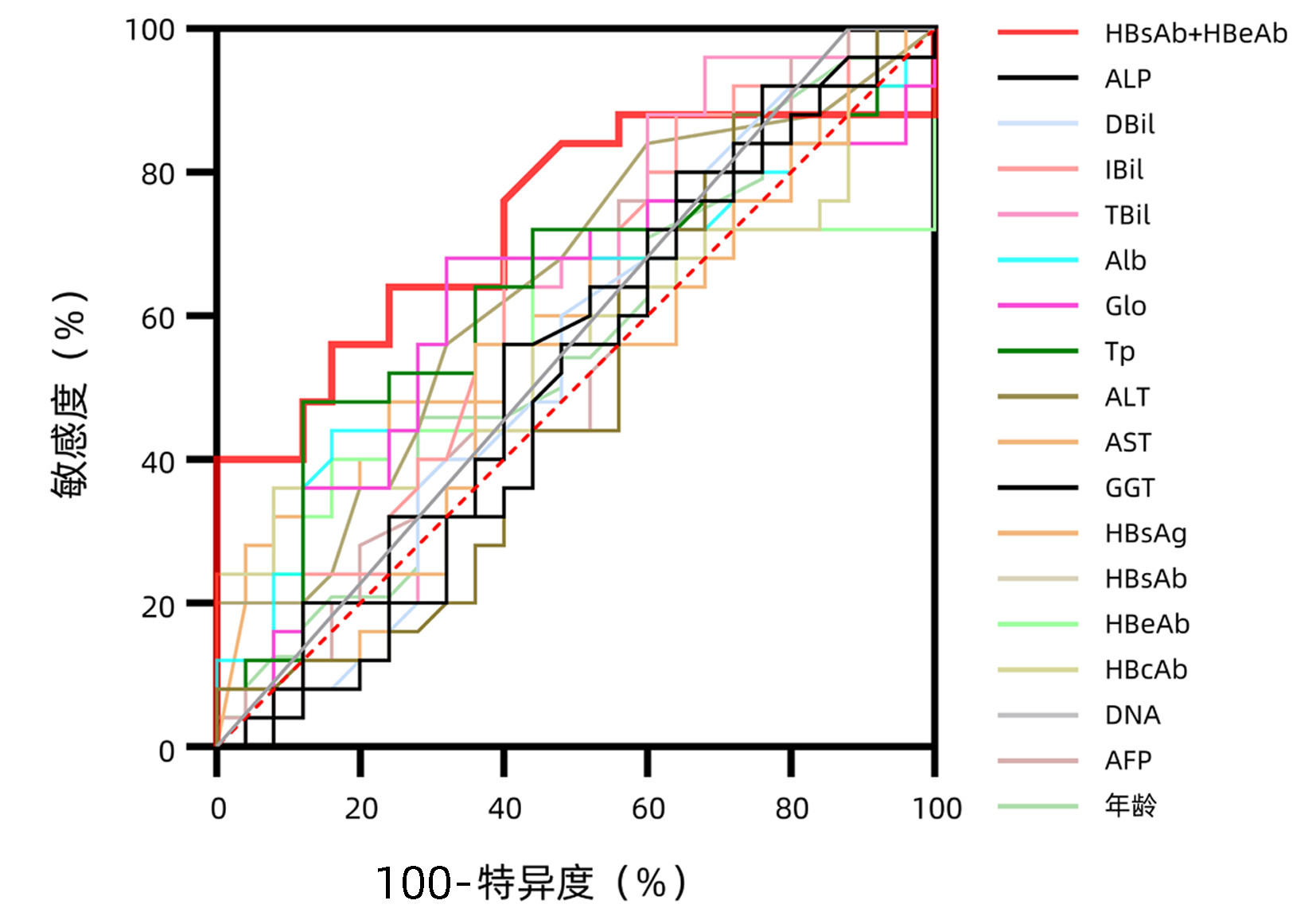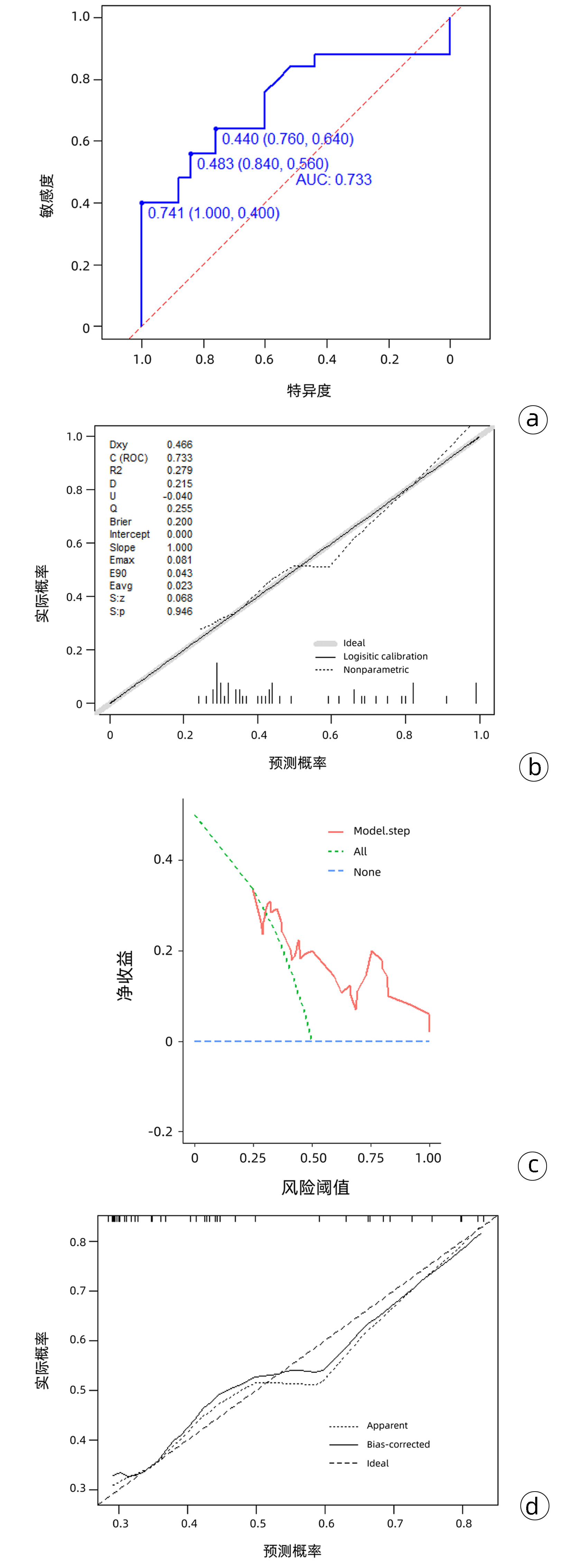抗-HBs联合抗-HBe对HBsAg/HBeAg/抗-HBc阳性患者HBeAg血清学转换的预测价值
DOI: 10.3969/j.issn.1001-5256.2023.08.011
Predictive value of anti-HBs+anti-HBe for seroconversion of HBeAg in patients with positive HBsAg/HBeAg/anti-HBc
-
摘要:
目的 建立HBsAg/HBeAg/抗-HBc阳性(以下简称“大三阳”)+抗-HBe阳性模式患者HBeAg血清学转换预测模型,并验证其预测价值。 方法 选取2018年4月1日—2022年8月1日于长江大学附属荆州医院行乙型肝炎血清标志物和HBV DNA定量检测的乙型肝炎患者6 055例,根据不同乙型肝炎血清学指标模式分为5组:HBsAg阴性组、HBsAg/抗-HBe/抗-HBc阳性组、大三阳+抗-HBe阳性组、大三阳+抗-HBs阳性组和大三阳组。分析不同乙型肝炎血清学指标模式的特点及不同组别中HBeAg水平的差异。非正态分布的多组连续性变量组间比较采用Kruskal-Wallis H检验。计数资料组间比较采用χ2检验。采用线性回归分析不同组别HBeAg水平差异。采用Logistic回归筛选独立影响因素,获得最优预测因子。通过受试者工作特征曲线(ROC曲线)验证预测效能。使用R Studio4.2.1建立预测模型并验证。 结果 与大三阳模式相比,大三阳+抗-HBe阳性、大三阳+抗-HBs阳性模式患者HBeAg水平均降低(P值均 < 0.01)。多因素Logistic回归分析显示,抗-HBe是HBeAg血清学转换的独立影响因素(P=0.014)。Lasso回归分析筛选结果显示,大三阳+抗-HBe阳性患者发生HBeAg血清学转换的最优预测因子为抗-HBe+抗-HBs。ROC曲线结果显示,抗-HBe+抗-HBs的AUC为0.733(95%CI: 0.588~0.878,P=0.004 8)。纳入抗-HBe+抗-HBs建立预测模型,其区分度(AUC=0.733)、准确度(C=0.733,B=0.20,P=0.946)、检测效能及稳定度(加强Bootstrap检验C=0.726)均表现良好。 结论 乙型肝炎患者体内抗-HBs或抗-HBe的出现均促进HBeAg水平下降,且抗-HBe促进HBeAg水平下降的能力强于抗-HBs。抗-HBe+抗-HBs可用于大三阳+抗-HBe阳性模式患者HBeAg血清学转换的预测。 Abstract:Objective To establish a predictive model for HBeAg seroconversion in patients with positive HBsAg/HBeAg/anti- HBc and anti-HBe, and to investigate the predictive value of this model. Methods A total of 6 055 patients with hepatitis B who received the quantification of the serum markers for hepatitis B and HBV DNA in Jingzhou Hospital Affiliated to Yangtze University from April 1, 2018 to August 1, 2022 were enrolled, and according to the pattern of serological markers for hepatitis B, they were divided into negative HBsAg group, positive HBsAg/anti-HBe/anti-HBc group, positive HBsAg/HBeAg/anti-HBc+positive anti-HBe group, positive HBsAg/HBeAg/anti- HBc+positive anti-HBs group, and positive HBsAg/HBeAg/anti-HBc group. The characteristics of different patterns of serological markers were analyzed, and the level of HBeAg was compared between groups. The Kruskal-Wallis H test was used for comparison of non-normally distributed continuous variables between multiple groups; the chi-square test was used for comparison of categorical data between groups. The linear regression analysis was used to analyze the difference in HBeAg content between different groups; the logistic regression analysis was used to screen for independent influencing factors and obtain the optimal predictive factors. The receiver operating characteristic (ROC) curve analysis was used to validate the predictive performance of the model. R Studio4.2.1 was used to establish and validate the predictive model. Results Compared with the positive HBsAg/anti-HBe/anti-HBc group, the positive HBsAg/HBeAg/anti-HBc+positive anti-HBe group and the positive HBsAg/HBeAg/anti-HBc+positive anti-HBs group had a significant reduction in the level of HBeAg (both P < 0.01). The multivariate logistic regression analysis showed that anti-HBe was an independent influencing factor for HBeAg seroconversion (P=0.014), and the Lasso regression analysis showed that anti-HBe+anti-HBs was the optimal predictive factor for HBeAg seroconversion in the patients with positive HBsAg/HBeAg/anti- HBc and positive anti-HBe. The ROC curve analysis showed that anti-HBe+ anti-HBs had an area under the ROC curve (AUC) of 0.733 (95% confidence interval: 0.588-0.878, P=0.004 8). Anti-HBe+anti-HBs was included to establish a predictive model, which had good discriminatory ability (AUC=0.733), accuracy (C=0.733, B=0.20, P=0.946), predictive performance, and stability (C=0.726 based on the enhanced Bootstrap test). Conclusion The presence of anti-HBs or anti-HBe in patients with hepatitis B promotes the reduction in HBeAg level, and anti-HBe had a stronger ability than anti-HBs in promoting such reduction. Anti-HBe+anti-HBs can be used to predict HBeAg seroconversion in patients with positive HBsAg/HBeAg/anti-HBc+positive anti-HBe. -
Key words:
- Hepatitis B Antigens /
- Seroconversion /
- Forecasting
-
表 1 不同乙型肝炎血清学指标模式患者各指标水平比较
Table 1. Comparison of the level of each index in patients with different modes of hepatitis B
指标 HBsAg阴性组(n=1 162) 小三阳组(n=3 917) 大三阳+抗- HBe阳性组(n=150) 大三阳+抗- HBs阳性组(n=21) 大三阳组(n=805) 统计值 P值 性别(例) χ2=17.316 0.001 7 男 620 2301 93 11 497 女 542 1616 57 10 308 年龄(岁) 48.0(38.0~55.0) 47.0(37.0~54.0) 41.0(31.5~49.0) 48.0(33.5~60.0) 33.0(28.0~43.0) H=479.634 < 0.01 HBV DNA(log10 IU/mL) 0.0 0.0(0.0~3.2) 0.0(0.0~4.5) 5.1(2.2~6.5) 3.2(0.0~7.5) H=958.469 < 0.01 HBsAg(IU/mL) 0.0 170.6(21.9~691.2) 1 104.8(527.1~2 273.3) 621.1(51.2~2 500.0) 2 500.0(666.3~2 500.0) H=3 467.578 < 0.01 抗-HBs(mIU/mL) 38.0(3.1~291.3) 0.3(0.1~0.5) 0.2(0.1~0.5) 19.1(14.2~37.2) 0.2(0.1~0.5) H=2 107.538 < 0.01 HBeAg(COI) 0.01) 0.01) 3.7(1.9~8.9)1) 279.4(10.8~1 161.9)1) 337.3(11.25~4 861.8) H=4 652.619 < 0.01 抗-HBe(Inh%) 63.4(52.6~87.2) 99.9(98.3~100.0) 58.2(54.0~64.6) 0.5(0.0~22.8) 0.0(0.0~35.3) H=3 500.625 < 0.01 抗-HBc(COI) 22.0(5.2~103.9) 539.9(302.4~718.2) 477.6(315.3~611.8) 545.3(289.9~638.1) 316.4(153.9~506.9) H=2 098.947 < 0.01 注:与大三阳组比较,1)P < 0.01。 表 2 发生HBeAg血清学转换的大三阳+抗-HBe阳性患者的单因素及多因素回归分析
Table 2. Univariate and multivariate regression analysis of coexistence of HBeAg and HBeAb with HBeAg Seroconversion
因素 单因素回归分析 多因素回归分析 OR (95%CI) P值 OR (95%CI) P值 性别 1.210(0.360~4.065) 0.758 0.290 年龄(岁) 1.019(0.971~1.070) 0.446 0.129 AFP(ng/mL) 0.772(0.413~1.444) 0.417 0.928 HBV DNA(log10 IU/mL) 0.999(0.999~1.000) 0.999 0.999 HBsAg(IU/mL) 0.999(0.998~1.000) 0.420 0.237 抗-HBs(mIU/mL) 1.090(0.823~1.443) 0.549 0.609 抗-HBe(Inh%) 1.012(0.982~1.042) 0.440 1.218(1.041~1.424) 0.014 抗-HBc(COI) 1.001(0.997~1.002) 0.745 0.455 DBil(μmol/L) 0.989(0.948~1.032) 0.608 0.403 IBil(μmol/L) 0.992(0.923~1.066) 0.818 0.309 TBil(μmol/L) 0.994(0.968~1.021) 0.670 0.451 Alb(g/L) 1.041(0.923~1.174) 0.514 0.733 A/G 0.609(0.087~4.249) 0.617 0.166 Glo(g/L) 1.079(0.950~1.225) 0.243 0.308 TP(g/L) 1.048(0.966~1.137) 0.263 0.693 ALT(U/L) 0.998(0.994~1.002) 0.340 0.226 AST(U/L) 0.996(0.987~1.006) 0.456 0.183 GGT(U/L) 0.998(0.990~1.006) 0.667 0.676 ALP(U/L) 1.001(0.975~1.025) 0.997 0.956 -
[1] DUAN MX, GU YN, YU MC, et al. Reasons and clinical significance of HBeAg and anti-HBe double positive in patients with chronic hepatitis B[J]. Chin J Nosocomiology, 2017, 27(19): 4332-4335. https://www.cnki.com.cn/Article/CJFDTOTAL-ZHYY201719004.htm段梦夕, 谷娅楠, 于淼琛, 等. 慢性乙型肝炎患者HBeAg与抗-HBe双阳性的原因与临床意义[J]. 中华医院感染学杂志, 2017, 27(19): 4332-4335. https://www.cnki.com.cn/Article/CJFDTOTAL-ZHYY201719004.htm [2] Chinese Society of Infectious Diseases, Chinese Medical Association; Chinese Society of Hepatology, Chinese Medical Association. Guidelines for the prevention and treatment of chronic hepatitis B (version 2019)[J]. J Clin Hepatol, 2019, 35(12): 2648-2669. DOI: 10.3969/j.issn.1001-5256.2019.12.007.中华医学会感染病学分会, 中华医学会肝病学分会. 慢性乙型肝炎防治指南(2019年版)[J]. 临床肝胆病杂志, 2019, 35(12): 2648-2669. DOI: 10.3969/j.issn.1001-5256.2019.12.007. [3] GU ZY, WANG AH, HE WC, et al. Influencing factors for HBeAg seroconversion in patients with chronic hepatitis B[J]. J Clin Hepatol, 2022, 38(11): 2581-2585. DOI: 10.3969/j.issn.1001-5256.2022.11.029.顾子杨, 王安辉, 何文昌, 等. 慢性乙型肝炎患者HBeAg血清学转换影响因素的研究进展[J]. 临床肝胆病杂志, 2022, 38(11): 2581-2585. DOI: 10.3969/j.issn.1001-5256.2022.11.029. [4] YAO CC, LEE CM, HUNG CH, et al. Combining age and HBsAg level predicts post-treatment durability of nucleos(t)ide analogue-induced HBeAg seroconversion[J]. J Gastroenterol Hepatol, 2015, 30(5): 918-924. DOI: 10.1111/jgh.12874. [5] GISH RG, CHANG TT, LAI CL, et al. Quantitative hepatitis B surface antigen analysis in hepatitis B e antigen-positive nucleoside-naive patients treated with entecavir[J]. Antivir Ther, 2013, 18(5): 691-698. DOI: 10.3851/IMP2559. [6] ZOULIM F, CAROSI G, GREENBLOOM S, et al. Quantification of HBsAg in nucleos(t)ide-naïve patients treated for chronic hepatitis B with entecavir with or without tenofovir in the BE-LOW study[J]. J Hepatol, 2015, 62(1): 56-63. DOI: 10.1016/j.jhep.2014.08.031. [7] YANG SC, LU SN, LEE CM, et al. Combining the HBsAg decline and HBV DNA levels predicts clinical outcomes in patients with spontaneous HBeAg seroconversion[J]. Hepatol Int, 2013, 7(2): 489-499. DOI: 10.1007/s12072-012-9382-3. [8] GENG MF, LI YX, GAO FY, et al. A scoring model predicts hepatitis B e antigen seroconversion in chronic hepatitis B patients treated with nucleos(t)ide analogs: Real-world clinical practice[J]. Int J Infect Dis, 2017, 62: 18-25. DOI: 10.1016/j.ijid.2017.06.016. [9] WANG Y, LIAO H, DENG Z, et al. Serum HBV RNA predicts HBeAg clearance and seroconversion in patients with chronic hepatitis B treated with nucleos(t)ide analogues[J]. J Viral Hepat, 2022, 29(6): 420-431. DOI: 10.1111/jvh.13671. [10] WANG B, CAREY I, BRUCE M, et al. HBsAg and HBcrAg as predictors of HBeAg seroconversion in HBeAg-positive patients treated with nucleos(t)ide analogues[J]. J Viral Hepat, 2018, 25(8): 886-893. DOI: 10.1111/jvh.12889. [11] HUANG YJ, CHANG CS, PENG YC, et al. On-treatment HBV DNA level could predict HBeAg seroclearance in patients with HBeAg-positive chronic hepatitis B with entecavir therapy[J]. J Chin Med Assoc, 2017, 80(6): 341-346. DOI: 10.1016/j.jcma.2016.12.005. [12] PENG CY, HSIEH TC, HSIEH TY, et al. HBV-DNA level at 6 months of entecavir treatment predicts HBeAg loss in HBeAg-positive chronic hepatitis B patients[J]. J Formos Med Assoc, 2015, 114(4): 308-313. DOI: 10.1016/j.jfma.2013.10.023. [13] JI X, XIA MY, ZHOU B, et al. Serum hepatitis B virus RNA levels predict HBeAg seroconversion and virological response in chronic hepatitis B patients with high viral load treated with nucleos(t)ide analog[J]. Infect Drug Resist, 2020, 13: 1881-1888. DOI: 10.2147/IDR.S252994. [14] ZHANG M, LI GD, SHANG J, et al. Rapidly decreased HBV RNA predicts responses of pegylated interferons in HBeAg-positive patients: A longitudinal cohort study[J]. Hepatol Int, 2020, 14(2): 212-224. DOI: 10.1007/s12072-020-10015-3. [15] WANG Y, LIAO H, DENG ZP, et al. Serum HBV RNA predicts HBeAg clearance and seroconversion in patients with chronic hepatitis B treated with nucleos(t)ide analogues[J]. J Viral Hepat, 2022, 29(6): 420-431. DOI: 10.1111/jvh.13671. [16] LUO H, ZHANG XX, CAO LH, et al. Serum hepatitis B virus RNA is a predictor of HBeAg seroconversion and virological response with entecavir treatment in chronic hepatitis B patients[J]. World J Gastroenterol, 2019, 25(6): 719-728. DOI: 10.3748/wjg.v25.i6.719. [17] JIA W, ZHU MQ, QI X, et al. Serum hepatitis B virus RNA levels as a predictor of HBeAg seroconversion during treatment with peginterferon alfa-2a[J]. Virol J, 2019, 16(1): 61. DOI: 10.1186/s12985-019-1152-6. [18] ZHAO XG, WANG J, LIU JC, et al. Baseline serum hepatitis B core antibody level predicts HBeAg seroconversion in patients with HBeAg-positive chronic hepatitis B after antiviral treatment[J]. Antiviral Res, 2021, 193: 105146. DOI: 10.1016/j.antiviral.2021.105146. [19] WANG CT, ZHANG YF, SUN BH, et al. Models for predicting hepatitis B e antigen seroconversion in response to interferon-α in chronic hepatitis B patients[J]. World J Gastroenterol, 2015, 21(18): 5668-5676. DOI: 10.3748/wjg.v21.i18.5668. [20] FAN R, SUN J, YUAN Q, et al. Baseline quantitative hepatitis B core antibody titre alone strongly predicts HBeAg seroconversion across chronic hepatitis B patients treated with peginterferon or nucleos(t)ide analogues[J]. Gut, 2016, 65(2): 313-320. DOI: 10.1136/gutjnl-2014-308546. [21] CAI SH, LI ZD, YU T, et al. Serum hepatitis B core antibody levels predict HBeAg seroconversion in chronic hepatitis B patients with high viral load treated with nucleos(t)ide analogs[J]. Infect Drug Resist, 2018, 11: 469-477. DOI: 10.2147/IDR.S163038. [22] FU XH, LOU HB, CHEN F, et al. Hepatitis B core antibody and liver stiffness measurements predict HBeAg seroconversion in HBeAg-positive chronic hepatitis B patients with minimally elevated alanine aminotransferase (ALT) levels[J]. Clin Exp Med, 2020, 20(2): 241-248. DOI: 10.1007/s10238-019-00603-5. [23] XU WZ, TONG YQ, LI Y. Comparison of Roche Elecsys and Sysmex HISCL immunoassays for the screening of common blood-borne pathogens[J]. Ann Transl Med, 2019, 7(14): 300. DOI: 10.21037/atm.2019.05.83. [24] WIJAYA RS, READ SA, TRUONG NR, et al. HBV vaccination and HBV infection induces HBV-specific natural killer cell memory[J]. Gut, 2021, 70(2): 357-369. DOI: 10.1136/gutjnl-2019-319252. [25] TSUKUDA S, WATASHI K. Hepatitis B virus biology and life cycle[J]. Antiviral Res, 2020, 182: 104925. DOI: 10.1016/j.antiviral.2020.104925. [26] KEENAN BP, FONG L, KELLEY RK. Immunotherapy in hepatocellular carcinoma: The complex interface between inflammation, fibrosis, and the immune response[J]. J Immunother Cancer, 2019, 7(1): 267. DOI: 10.1186/s40425-019-0749-z. [27] CHEN T, ZHU L, SHI AC, et al. Functional restoration of CD56bright NK cells facilitates immune control via IL-15 and NKG2D in patients under antiviral treatment for chronic hepatitis B[J]. Hepatol Int, 2017, 11(5): 419-428. DOI: 10.1007/s12072-017-9803-4. [28] HU X, MA S, HUANG X, et al. Interleukin-21 is upregulated in hepatitis B-related acute-on-chronic liver failure and associated with severity of liver disease[J]. J Viral Hepat, 2011, 18(7): 458-467. DOI: 10.1111/j.1365-2893.2011.01475.x. [29] YANG JZ, SHENG GP, XIAO DS, et al. The frequency and skewed T-cell receptor beta-chain variable patterns of peripheral CD4(+)CD25(+) regulatory T-cells are associated with hepatitis B e antigen seroconversion of chronic hepatitis B patients during antiviral treatment[J]. Cell Mol Immunol, 2016, 13(5): 678-687. DOI: 10.1038/cmi.2015.100. [30] XIA J, HUANG R, CHEN YX, et al. Profiles of serum soluble programmed death-1 and programmed death-ligand 1 levels in chronic hepatitis B virus-infected patients with different disease phases and after anti-viral treatment[J]. Aliment Pharmacol Ther, 2020, 51(11): 1180-1187. DOI: 10.1111/apt.15732. [31] AN X, LIU SH, XIA LN, et al. Efficacy and clinical outcomes of different antiviral regimens in HBeAg/HBeAb double-positive patients with chronic hepatitis B[J]. J Army Med Univ, 2022, 44(2): 162-167. DOI: 10.16016/j.2097-0927.202107114.安选, 刘书宏, 夏莉娜, 等. HBeAg/HBeAb双阳性慢性乙型肝炎患者不同抗病毒方案疗效及临床转归分析[J]. 陆军军医大学学报, 2022, 44(2): 162-167. DOI: 10.16016/j.2097-0927.202107114. [32] LUO L, ZHANG TC, LIU SG. Clinical characteristics of chronic hepatitis B patients with both HBeAg and HBeAb positive[J]. J Mol Diagn Ther, 2019, 11(5): 387-390, 433. DOI: 10.3969/j.issn.1674-6929.2019.05.011.罗琳, 张廷超, 刘书刚. HBeAg与抗-HBe双阳性的慢性乙型肝炎患者临床特征分析[J]. 分子诊断与治疗杂志, 2019, 11(5): 387-390, 433. DOI: 10.3969/j.issn.1674-6929.2019.05.011. [33] WANG H, WANG HP, QIAN LY, et al. Maternal breast feeding safety of hepatitis B virus carrying parturient women with hepatitis B surface antigen and hepatitis B e antigen double positive[J]. Chin J Infect Dis, 2020, 38(1): 44-48. DOI: 10.3760/cma.j.issn.1000-6680.2020.01.006.王虹, 王红萍, 钱琳妍, 等. 乙型肝炎表面抗原和乙型肝炎e抗原双阳性的乙型肝炎病毒携带产妇进行母乳喂养的安全性[J]. 中华传染病杂志, 2020, 38(1): 44-48. DOI: 10.3760/cma.j.issn.1000-6680.2020.01.006. [34] KAO JH, CHEN PJ, LAI MY, et al. Hepatitis B virus genotypes and spontaneous hepatitis B e antigen seroconversion in Taiwanese hepatitis B carriers[J]. J Med Virol, 2004, 72(3): 363-369. DOI: 10.1002/jmv.10534. [35] SHIMAKAWA Y, LEMOINE M, NJAI HF, et al. Natural history of chronic HBV infection in West Africa: A longitudinal population-based study from The Gambia[J]. Gut, 2016, 65(12): 2007-2016. DOI: 10.1136/gutjnl-2015-309892. [36] KRAMVIS A, KOSTAKI EG, HATZAKIS A, et al. Immunomodulatory function of HBeAg related to short-sighted evolution, transmissibility, and clinical manifestation of hepatitis B virus[J]. Front Microbiol, 2018, 9: 2521. DOI: 10.3389/fmicb.2018.02521. -



 PDF下载 ( 2625 KB)
PDF下载 ( 2625 KB)


 下载:
下载:





